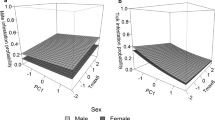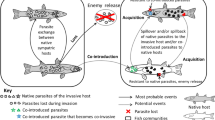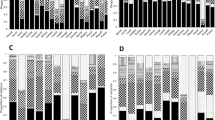Abstract
Deviance partitioning can provide new insights into the ecology of host-parasite interactions. We studied the host-related factors influencing parasite prevalence, abundance, and species richness in European brown hares (Lepus europaeus) from northern Spain. We defined three groups of explanatory variables: host environment, host population, and individual factors. We hypothesised that parasite infection rates and species richness were determined by different host-related factors depending on the nature of the parasite (endo- or ectoparasite, direct or indirect life cycle). To assess the relative importance of these components, we used deviance partitioning, an innovative approach. The explained deviance (ED) was higher for parasite abundance models, followed by those of prevalence and then by species richness, suggesting that parasite abundance models may best describe the host factors influencing parasitization. Models for parasites with a direct life cycle yielded higher ED values than those for indirect life cycle ones. As a general trend, host individual factors explained the largest proportion of the ED, followed by host environmental factors and, finally, the interaction between host environmental and individual factors. Similar hierarchies were found for parasite prevalence, abundance, and species richness. Individual factors comprised the most relevant group of explanatory variables for both types of parasites. However, host environmental factors were also relevant in models for indirect life-cycle parasites. These findings are consistent with the idea of the host as the main habitat of the parasite; whereas, for indirect life-cycle parasites, transmission would be also modulated by environmental conditions. We suggest that parasitization can be used not only as an indicator of individual fitness but also as an indicator of environmental quality for the host. This research underlines the importance of monitoring parasite rates together with environmental, population, and host factors.




Similar content being viewed by others
References
Acevedo P, Vicente J, Alzaga V, Gortázar C (2005) Relationship between bronchopulmonary nematode larvae and relative abundances of Spanish ibex (Capra pyrenaica hispanica) from Castilla-La Mancha, Spain. J Helminthol 79:113–118
Acevedo P, Vicente J, Höfle U, Cassinello J, Ruiz-Fons F, Gortázar C (2007a) Estimation of European wild boar relative abundance and aggregation: a novel method in epidemiological risk assessment. Epidemiol Infect 135:519–527
Acevedo P, Cassinello J, Hortal J, Gortázar C (2007b) Invasive exotic aoudad (Ammotragus lervia) as a major threat to native Iberian ibex (Capra pyrenaica): a habitat suitability model approach. Divers Distrib 13:587–597
Alzaga V, Vicente J, Villanúa D, Acevedo P, Casas F, Gortázar C (2008) Body condition and parasite intensity correlates with escape capacity in Iberian hares (Lepus granatensis). Behav Ecol Sociobiol 62:769–775
Anderson RC (2000) Nematode parasites of vertebrates. Their development and transmission. CABI Publishing, New York
Anderson RM, May RM (1978) Regulation and stability of host-parasite population interactions. I. Regulatory processes. J Anim Ecol 47:219–247
Arneberg P (2002) Host population density and body mass as determinants of species richness in parasite communities: comparative analyses of directly transmitted nematodes in mammals. Ecography 25:88–94
Ash LR, Orihel TC (1991) Parasites: a guide to laboratory procedures and identification. American Society of Clinical Pathology, Chicago
Austin MP, Nicholls AO, Margules CR (1990) Measurement of the realized qualitative niche: environmental niche of five Eucalyptus species. Ecol Monogr 60:161–177
Barbosa AM, Segivia JM, Vargas JM, Torres J, Real R, Miquel J (2005) Predictors of red fox (Vulpes vulpes) helminth parasite diversity in the provinces of Spain. Wildlife Biology in Practice 1:3–14
Barnes RFW, Tapper SC (1985) A method for counting hares by spotlight. J Zool 206:273–276
Bordes F, Blumstein DT, Morand S (2007) Rodent sociality and parasite diversity. Biol Lett 3:692–694
Bordes F, Morand S, Kelt DA, vanVuren DH (2009) Home range and parasite diversity in mammals. Am Nat 173:1–9
Brown CR, Brown MB (2004) Empirical measurement of parasite transmission between groups in a colonial bird. Ecology 85:1619–1626
Bush AO, Lafferty KD, Lotz JM, Shostak AW (1997) Parasitology meets ecology on its own terms: Margolis et al. revisited. J Parasitol 83(4):575–583
Carbonell R, Pérez-Tris J, Tellería JL (2003) Effects of habitat heterogeneity and local adaptation on the body condition of a forest passerine at the edge of its distributional range. Biol J Linn Soc 78(4):479–488
Caron A, Cross PC, Du Toit JT (2003) Ecological implications of bovine tuberculosis in African buffalo herds. Ecol Appl 13:1338–1345
Carrete M, Grande JM, Tella JL, Sanchez-Zapata JA, Donazara JA, Diaz-Delgado R, Romo A (2007) Habitat, human pressure, and social behaviour: partialling out factors affecting large-scale territory extinction in an endangered vulture. Biol Conserv 136(1):143–154
Cattadori IM, Haydon DT, Hudson PJ (2005a) Parasites and climate synchronize red grouse populations. Nature 433:737–741
Cattadori IM, Boag B, Bjørnstad ON, Cornell SJ, Hudson PJ (2005b) Peak shift and epidemiology in a seasonal host-nematode system. Proc R Soc Lond B 272:1163–1169
Clark Laboratories (2004) Idrisi Kilimanjaro version 14.02. GIS software package. Clark University, Worcester, UK
Clemons C, Rickard LG, Keirans JE, Botzler RG (2000) Evaluation of host preferences by helminths and ectoparasites among black-tailed jackrabbits in northern California. J Wildl Dis 36:555–558
Corbin E, Vicente J, Martin-Hernando MP, Acevedo P, Pérez-Rodriguez L, Gortázar C (2008) Spleen mass as a measure of immune strength in mammals. Mamm Rev 38:108–115
Cote SD, Stien A, Irvine RJ, Dallas JF, Marshall F, Halvorsen O, Langvatn R, Albon SD (2005) Resistance to abomasal nematodes and individual genetic variability in reindeer. Mol Ecol 14:4159–4168
Franklin AB, Anderson DR, Gutierrez RJ, Burnham KP (2000) Climate, habitat quality and fitness in northern Spotted owl populations in northwestern California. Ecol Monogr 70(4):539–590
Gaston KJ, Lawton JH (1988) Patterns in the distribution and abundance of insect populations. Nature 331:709–712
Georgi JR, Georgi ME (1990) Parasitology for veterinarian, 5th edn. W.B. Saunders Company, Philadelphia, Pensilvania
Gil Collado J, Guillén Llera JL, Zapatero Ramos LM (1979) Claves para la identificación de los Ixodoidea españoles (adultos). Rev Iber Parasitol 39:107–118
Gillespie TR, Chapman CA (2006) Prediction of parasite infection dynamics in primate metapopulations based on attributes of forest fragmentation. Conserv Biol 20:441–448
Gortázar C, Millán J, Acevedo P, Escudero MA, Marco J, Fernández de Luco D (2007) A large-scale survey of brown hare Lepus europaeus and Iberian hare L. granatensis populations at the limit of their ranges. Wildlife Biol 13:244–250
Gregory RD (1997) Comparative studies of host-parasite communities. In: Clayton DH, Moore J (eds) Host-parasite evolution. General principles and avian models. Oxford University Press, New York, pp 198–211
Grenfell BT, Dobson AP (1995) Ecology of infectious diseases in natural populations. Cambridge University Press, Cambridge
Guègan JF, Morand S, Poulin R (2005) Are there general lwas in parasite community ecology? The emergence of spatial parasitology and epidemiology. In: Thomas F, Renaud F, Guègan JF (eds) Parasitism and ecosystems. Oxford University Press, New York, pp 22–42
Hatcher MJ, Dick JTA, Dunn AM (2006) How parasites affect interactions between competitors and predators. Ecol Lett 9:1253–1271
Heikkinen R, Luoto M, Kuussaari M, Poyry J (2005) New insights into butterfly-environment relationships using partitioning methods. Proc R Soc Lond B 272:2203–2210
Hirzel A, Helfer V, Métral F (2001) Assessing habitat-suitability models with a virtual species. Ecol Model 145:111–121
Hirzel AH, Hausser J, Perrin N (2002a) Biomapper 3.1. Lausanne, Lab. For Conservation Biology. URL: http://www.unil.ch/biomapper
Hirzel AH, Hausser J, Chessel D, Perrin N (2002b) Ecological niche factor analysis: how to compute habitat-suitability maps without absence data? Ecology 83:2027–2036
Hogue C, Swig B (2007) Habitat quality and endoparasitism in the Pacific sanddab Citharichthys sordidus from Santa Monica Bay, southern California. J Fish Biol 70:231–242
Hudson PJ, Dobson AP (1995) Macroparasites: observed patterns in naturally fluctuating animal populations. In: Grenfell BT, Dobson AP (eds) Ecology of infectious diseases in natural populations. Cambridge University Press, Cambridge, pp 144–177
Hudson PJ, Rizzoli A, Grenfell BT, Heesterbeek H, Dobson AP (2002) The ecology of wildlife diseases. Oxford University Press, New York
Hutchings MR, Gordon IJ, Kyriazakis I (2002) Grazing in heterogeneous environments: infra- and supraparasite distributions determine herbivore grazing decisions. Oecologia 132:453–460
Khalil LF, Jones A, Bray RA (1994) Keys to the cestode parasites of vertebrates. CAB International, Wallingford
Krebs CJ, Singleton GR (1993) Indexes of condition for small mammals. Aust J Zool 41:317–323
Legendre P (1993) Spatial autocorrelation: trouble or new paradigm? Ecology 74:1659–1673
Legendre P, Legendre L (1998) Numerical ecology, 3rd edn. Elsevier publishers, Amsterdam, Holland
Matson KD (2006) Are there differences in immune function between continental and insular birds? Proc R Soc Lond B 273:2267–2274
Molina X, Casanova JC, Feliu C (1999) Influence of host weight, sex and reproductive status on helminth parasites of the wild rabbit, Oryctolagus cuniculus, in Navarra, Spain. J Helminthol 73:221–225
Möller AP, Christe P, Erritzöe J, Mavarez J (1998) Condition, disease and immune defense. Oikos 83:301–306
Morand S, Poulin R (1998) Density, body mass and parasite species richness of terrestrial mammals. Evol Ecol 12:717–727
Morand S, Poulin R (2000) Nematode parasite species richness and the evolution of spleen size in birds. Can J Zool 78:1356–1360
Moreno JM, Pineda FD, Rivas-Martínez S (1990) Climate and vegetation at the Eurosiberian-Mediterranean boundary in the Iberian Peninsula. J Veg Sci 1(2):233–244
Murray DL, Keith LB, Cary JR (1998) Do parasitism and nutritional status interact to affect production in snowshoe hares? Ecology 79:1209–1222
Ninyerola M, Pons X, Roure JM (2005) Atlas Climático Digital de la Península Ibérica. Metodología y aplicaciones en bioclimatología y geobotánica. Universidad Autónoma de Barcelona, Bellaterra. ISBN 932860-8-7
Nunn C, Altizer S, Jones KE, Sechrest W (2003) Comparative tests of parasite species richness in primates. Am Nat 162:597–614
O’Connor LJ, Walkden-Brown SW, Kahn LP (2006) Ecology of the free-living stages of major trichostrongylid parasites of sheep. Vet Parasitol 142:1–15
Palomo LJ, Gisbert J (2002) Atlas de los Mamíferos Terrestres de España. Dirección General de Conservación de la Naturaleza-SECEM-SECEMU, Madrid
Patterson B, Dick C, Dittmar K (2008) Parasitism by bat flies (Diptera: Streblidae) on neotropical bats: effects of host body size, distribution, and abundance. Parasitol Res 103(5):1091–1100
Pellerdy L (1974) Coccidia and coccidiosis, 2nd edn. Verlag Paul Parey, Berlin
Pérez JM, Meneguz PG, Dematteis A, Rossi L, Serrano E (2006) Parasites and conservation biology: the ‘ibex-ecosystem’. Biodivers Conserv 15:2033–2047
Peroux R (1995) La lièvre d´Europe. Bull Mens Off Natl Chasse 204:1–96
Poiani A (1992) Ectoparasitism as a posssible cost of social life: a comparative analysis using Australian passerines (Passeriformes). Oecologia 92:429–441
Poulin R (2004) Macroecological patterns of species richness in parasite assemblages. Basic Appl Ecol 5:423–434
Poulin R (2007) Are there general laws in parasite ecology? Parasitology 134(6):763–776
Real R, Barbosa AM, Porras D, Kin MS, Marquez AL, Guerreo JC, Palomo J, Justo ER, Vargas JM (2003) Relative importance of environment, human activity and spatial situation in determining the distribution of terrestrial mammal diversity in Argentina. J Biogeogr 30:939–947
Rohani P, Earn JD, Grenfell BT (1999) Opposite patterns of synchrony in sympatric disease metapopultions. Science 286:968–971
Sacks BN, Woodward DL, Colwell AE (2003) A long-term study of non-native-heartworm transmission among coyotes in a Mediterranean ecosystem. Oikos 102:478–490
Skryabin KI (1991) Key to parasitic nematodes. E.J Brill Publishing Company, Leiden (The Netherlands)
Stroh G (1931) Zwei sichere Altersmerkmale beim Hasen. Berl TieraÉrztl Wochenschr 47:180–181
Telfer S, Birtles R, Bennett M, Lambin X, Paterson S, Begon M (2008) Parasite interactions in natural populations: insights from longitudinal data. Parasitology 135(7):767–781
Thieltges DW, Reise K (2007) Spatial heterogeneity in parasite infections at different spatial scales in an intertidal bivalve. Oecologia 150:569–581
Thomas F, Guegan J, Michalakis Y, Renaud F (2000) Parasites and host life-history traits: implications for community ecology and species co-existence. Int J Parasitol 30:669–674
Thomas F, Renaud F, Guégan JF (2004) Parasitism and ecosystems. Oxford University Press, New York
Tinsley RC (2005) Parasitism and hostile environments. In: Thomas F, Renaud F, Guegan F (eds) Parasitism and ecosystems. Oxford University Press, Oxford, UK, pp 85–111
Tompkins DM, Dobson AP, Arneberg P, Begon ME, Cattadori IM, Greenman JV, Heesterbeek H, Hudson PJ, Newborn B, Pugliese A, Rizzoli AP, Rosa R, Rosso F, Wilson K (2001) Parasites and host population dynamics. In: Hudson PJ, Rizzoli A, Grenfell BT, Heesterbeek H, Dobson AP (eds) The ecology of wildlife diseases. Oxford University Press, New York, pp 45–62
van Oort H, Otter KA (2005) Natal nutrition and the habitat distributions of male and female black-capped chickadees. Can J Zool 83:1495–1501
Vicente J, Fierro Y, Martínez M, Gortázar C (2004) Long-term epidemiology, effect on body condition and interspecific interactions of concomitant infection by nasopharyngeal bot fly larvae (Cephenemyia auribarbis and Pharyngomyia picta, Oestridae) in a population of Iberian red deer (Cervus elaphus hispanicus). Parasitology 129:349–361
Vicente J, Höfle U, Fernández-de-Mera IG, Gortázar C (2007a) The importance of parasite life history and host density in predicting the impact of infections in red deer. Oecologia 152:655–664
Vicente J, Pérez-Rodríguez L, Gortázar C (2007b) Sex, age, spleen size, and kidney fat of red deer relative to infection intensities of the lungworm Elaphostrongylus cervi. Naturwissenschaften 94:581–587
Villanúa D, Acevedo P, Höfle U, Rodríguez O, Gortázar C (2006) Changes in parasite transmission stage excretion after pheasant release. J Helminthol 80:1–7
Wilson K, Grenfell BT (1997) Generalized linear modeling for parasitologists. Parasitol Today 13:33–38
Wilson K, Björnstad ON, Dobson AP, Merler S, Poglayen G, Randolph SE, Read AF, Skorping A (2002) Heterogeneities in macroparasite infections:patterns and processes. In: Hudson PJ, Rizzoli A, Grenfell BT, Heesterbeek H, Dobson AP (eds) The ecology of wildlife diseases. Oxford University Press, New York, pp 6–44
Acknowledgements
Our gratitude to T. Czeschlik and four anonymous reviewers for their useful comments and suggestions on a previous version of our manuscript. This study was supported by the Cantabria Government. We thank Jesús Pérez (Cetyma), Julián Martín (Sociedad de Fomento de Caza y Pesca), and José Cobo for assistance in the sample collection, and Federación Cántabra de Caza for the support during sampling. V. Alzaga received a grant from Cantabria Government; P. Tizzani enjoyed a grant from Leonardo programme during IREC period; P. Acevedo is currently enjoying a Juan de la Cierva research contract awarded by the Ministerio de Ciencia e Innovación (MICINN) and is also supported by the project CGL2006-09567/BO; and F. Ruiz-Fons is supported by the “Instituto de Salud Carlos III” from the Ministerio de Sanidad y Consumo. The authors declare that samples were obtained from a legal hunting method. This study complies with the Spanish and Cantabrian laws. This hunting method obeys the Berne Convention agreements about wildlife capture methods (Annexe VI). We were not responsible for killing the hares and did not pay for the specimens.
Author information
Authors and Affiliations
Corresponding author
Rights and permissions
About this article
Cite this article
Alzaga, V., Tizzani, P., Acevedo, P. et al. Deviance partitioning of host factors affecting parasitization in the European brown hare (Lepus europaeus). Naturwissenschaften 96, 1157–1168 (2009). https://doi.org/10.1007/s00114-009-0577-y
Received:
Revised:
Accepted:
Published:
Issue Date:
DOI: https://doi.org/10.1007/s00114-009-0577-y




